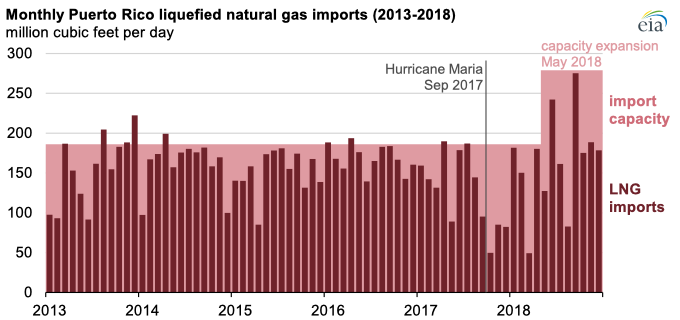In 2018, Puerto Rico’s liquefied natural gas (LNG) imports neared 2016 annual levels, according to the recently released LNG Annual Report published by the U.S. Department of Energy's Office of Fossil Energy. Imports into Puerto Rico were disrupted in 2017 after Hurricane Maria made landfall as a Category 4 hurricane on September 20, 2017. Puerto Rico imported 60.3 billion cubic feet (Bcf) of LNG in 2018, a level similar to the total LNG imports of 61.3 Bcf in 2016.
Puerto Rico relies on fuel imports to meet most of its power generation needs. Nearly half of its generation was fueled by petroleum products and one-third of its generation was fueled by natural gas in 2017. All of Puerto Rico’s LNG imports are used for electricity generation.

After Hurricane Maria made landfall in late September 2017, Puerto Rico’s LNG imports declined as less natural gas was needed during widespread electricity outages. In the last three months of the year, Puerto Rico only received one LNG cargo per month, averaging 78 MMcf/d and bringing the 2017 total average to 46.4 Bcf, or 24% lower than the previous year’s average.
Puerto Rico resumed its two-cargoes-per-month level of LNG imports four months after the hurricane, although restoration efforts on electricity infrastructure took much longer. By April 2018, the Puerto Rico Electric Power Authority (PREPA) had restored electric power to 95% of its customers.
In August 2017—the month before Hurricane Maria—the Federal Energy Regulatory Commission (FERC) had approved a 60% expansion of the Peñuelas regasification capacity, from 186 MMcf/d to 279 MMcf/d. According to FERC filings, EcóElectrica, L.P., the parent company, stated that disruption to the PREPA electric system and delays in restoration efforts had delayed the project from entering service until May 2018. Since the expansion, Puerto Rico’s imports increased and reached a monthly record volume of 275 MMcf/d in September 2018.
Puerto Rico is looking to further expand its natural gas consumption to displace fuel oil for electricity generation. However, the territory is currently limited in its ability to receive cargos from the Lower 48 states because of Jones Act restrictions. In December 2018, Puerto Rico requested a 10-year waiver to the Jones Act, which requires goods or passengers moved in U.S. coastal waters between U.S. ports to be carried on vessels that are U.S. constructed, owned, crewed, and flagged.
The 10-year waiver would allow Puerto Rico to move LNG from the Lower 48 states with prices benchmarked to the Henry Hub, or at prices that are lower than importing natural gas from foreign countries. Since September 2016, Puerto Rico has imported 100% of its LNG from Trinidad through long-term contracts.
Similar to other U.S. territories, LNG trade values for Puerto Rico are not included in U.S. national totals reported in EIA’s Natural Gas Monthly data series.
Principal contributor: Kristen Tsai

Follow us on social media: